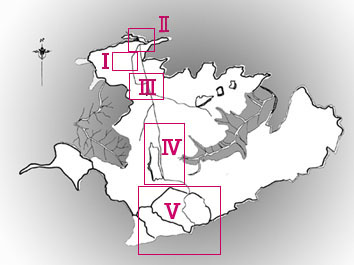 |
I. Palace Complex II. The neighbourhood of the north gate |
MANDU
Mandu is impregnable, on a plateau looking down upon the
Nalmada river in the south. Currently, several historical remains
dot in jungle and only a few private houses situate in the
central part of Mandu. This fortress was already known as being
eminent in a Hindu Kingdom of the Paramara Dynasty that ruled
this region from the 8-13th century. After the early 12th
century, it was attacked by Muslims of various Delhi Dynasties
and became a battlefield. At the end of 14th century, Dilawar
Khan Ghori (d. 1405) established an independent kingdom, whose
capital is Dhar, in 35km north. Being called Mandu Shadiabad
(town of joy), this town became his favourite retreat. His son,
Hoshang Shah (reign 1405-1432) made this town the capital in the
early 15th century. From then to the establishment of the Mughal,
Mandu enjoyed its most prosperous period. Historical remains
concentrate on this period, as if they prove its prosperity.
Mandu is a fort constructed using
natural geographic features, and its shape is complicated. Its
main gate is Delhi Gate, situated on a road from Dhar in the
north and it had been rebuild repeatedly before the Mughal
period. The current main road of Mandu runs under this north
gate, passing the east shore of the biggest lake Sagar Talao
situated in the centre and going down to the south of the fort.
Palace buildings are in between Munja
Talao and Kapur Talao, which situate in the southwest side of the
north gate, thus we called this area "Palace Complex".
In the area between the palace complex and the north gate, there
are some buildings remaining, thus we named this area "the
neighbourhood of the north gate". Going further south from
this part, one can see a building complex, whose main building is
Jama Masjid; we call this area "the neighbourhood of Jama
Masjid". In the farther south side of this part, there are a
few mausoleums dotted on the east shore of Sagar Talao, thus we
named this area "east shore of Sagar Talao". Going
further south, we reach "south Fort".
(Since there are numerous remains in Mandu and the area is wide so is the number of photos, so we divide Mandu into 5 areas. )